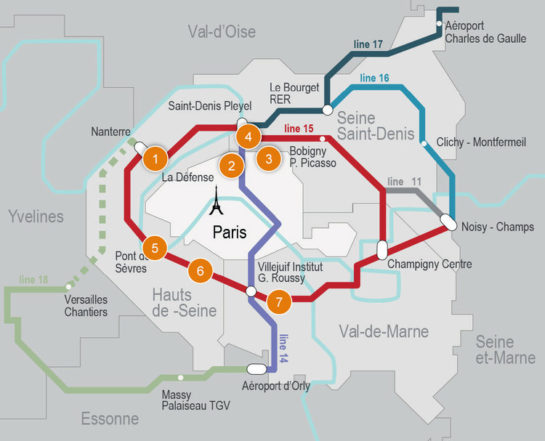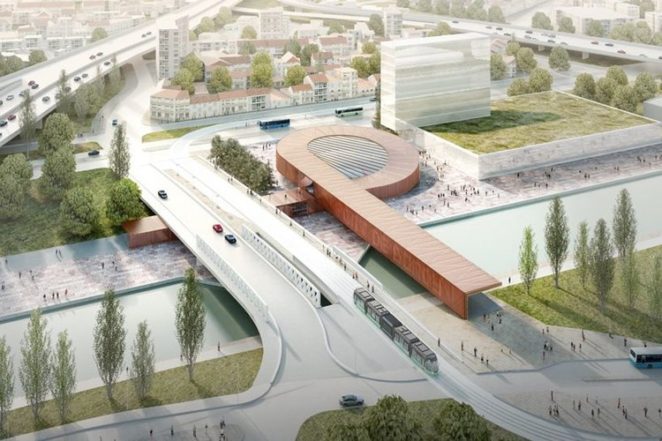
The $29.5 billion, 204-kilometer Grand Paris Express has been dubbed “the construction project of the century,” and to help ensure the modernization and expansion of the City of Light’s mass transit system goes as planned, engineering and construction teams alike are executing building information modeling(BIM).

One of the more prominent pieces of modeling software in play is Autodesk’s AutoCAD Civil 3D, along with Revit to support architectural-, structural-, and MEP-related project components and activities. It’s a somewhat unusual approach, given that BIM isn’t used for infrastructure projects to the extent that it is for buildings, particularly when it comes to projects of the Grand Paris Express’s scope, according Autodesk civil engineer Lucy Kuhns. “While BIM has seen adoption for architecture, infrastructure has been several years behind,” Kuhns recently told reporters.
For the Grand Paris Express project, Civil 3D confers many of the same benefits as building-oriented programs do, including evaluation of feasibility and impact, automation of documents and reports, integration of software among users, facilitation of smoother and more consistent workflow, promotion of fewer field errors, and expedition of project modifications, according to Autodesk.
“BIM offers real progress by integrating all the graphical, non-graphical, and documentary data relating to an infrastructure project in a single model,” Paris-based engineer SYSTRA, holder of several key contracts for the Grand Paris Express, including tunnels, stations, and a maintenance facility, noted in a statement. “It combines and capitalizes on the production capabilities of all of SYSTRA’s businesses and helps with decision-making and communications starting at the design stage by placing the final project in its local environment.”
With the Grand Paris Express, however, SYSTRA and countless other designers and builders have their work cut out for them.
Due for completion in 2030, the 15-year project calls for the expansion and upgrading of Paris’s Metro system with the addition of four lines and the extension of two, the aim being to create a framework to spur urban, social, and economic development for the 12 million citizens who reside in the Paris metropolitan area. The greater objective is to consolidate Paris’s position as one of the world’s top global cities. Expectations are that the project will significantly stimulate regional economic activity, adding €140 billion to France’s GDP by establishing key linkages between Paris and its ring of outlying suburbs—in addition to linkages between suburbs designated as districts for several enterprises, including aeronautics, creativity, health, finance, and international exchange and events. As the districts develop, the state-established Societie du Grand Paris (SGP) expects to see 70,000 residences come on line annually.
The project, undertaken by SGP, officially broke ground in 2016 with the launch of a 75-kilometer circular rail line that will ring the city, connecting suburbs, though extension of an existing Parisian line commenced earlier, in 2015.
Significantly, some 85–90 percent of the new and refurbished lines will operate underground, some at depths of as much as 40 meters.
To negotiate such challenges, Civil 3D relies on parametric modeling, accounting for the characteristics of all project components, including geotechnical conditions, hydrology, tunnel, rail, rail alignment, existing utilities, and the like, in addition to interactions among each, according Autodesk’s Civil 3D Product Manager David Simeone. “We’re evaluating the impact of the soil on the tunnel, and tunnel on track and track alignment, and track and track alignment with structural plans for rail platforms,” Simeone says.
As civil engineers create models with Civil 3D, architects and structural and MEP engineers are doing the same with Revit. Although a degree of interoperability exists between the two programs, it isn’t until files are exported into Autodesk’s Navisworks that the pieces fall completely into place, allowing parties to identify clashes, establish quantities and pricing, address issues such as sequencing, and more, Simeone says.

Among other achievements, the Grand Paris Express’s modelers have negotiated the fragile nature of Paris’s subsoil, in addition to high gypsum levels at north and northeast locations. “Yes, the subsurface is tricky, especially since [the majority] of the network will be tunneled,” SGP President Phillipe Yvin noted in a statement.
“Geotechnical conditions are always of issue with projects like this,” says Drew Olsen, a senior industry strategy manager with Autodesk.
Work has not been without additional challenges that come with the territory. “Rather than a single building site, large infrastructure projects such as this extend for miles and miles through built environments, existing corridors and utilities, and so forth,” Olsen says. The variables are seemingly countless.
“One issue is that some of the information you need to know is not known until work begins in earnest, including grade data, rough surface information, the depths of different materials, core hole samples, and so forth,” Simeone says. “There is also the sheer number of stakeholders on the project, and corresponding requirements to coordinate their efforts, though provisions for such issues are built into our system.”
Creating models for surface, geologic strata and structures for the Grand Paris Express proved challenging, Kuhn told reporters. Once completed, however, the models simplified several other tasks. For instance, stakeholders could more easily visualize subterranean features than they would have been able to with 2-D sections, allowing them to better understand the manner in which tunnels, track, utilities, stations, and other elements converged.
Modeling has also introduced surprising speed to the process. The addition of a fault to geotechnical data proved so simple that “the geotechnical engineer’s jaw dropped,” Kuhn told reporters. “With the old process, it would have taken hours to generate a revised set of drawings. With BIM, we entered the new data and updated the model in a matter of seconds.”
Once completed, the Grand Paris Express’s stations and lines are expected to lie within 2 kilometers of regional residents, with subway waits reduced to 90 seconds. Additionally, subway transport will be automated. Grand, indeed.



Discussion
Be the first to leave a comment.
You must be a member of the BuiltWorlds community to join the discussion.